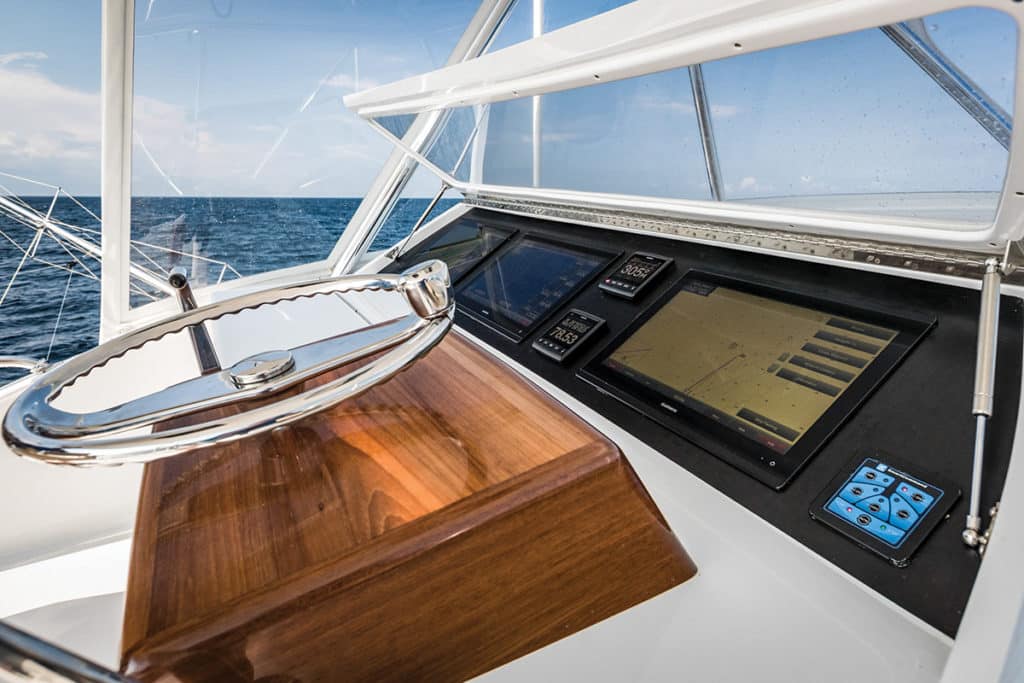
For the past five or six years, integrating audio-system control through multifunction navigation displays has been the hottest trend in audio — and it’s not cooling off, especially in larger boats with full navigation suites.
Fusion Entertainment was first to integrate audio systems through Lowrance and Simrad displays using a proprietary gateway protocol.
Soon, Furuno, Garmin, Humminbird and Raymarine offered Fusion-Link access to their systems and helped Navico develop SonicHub (a Navico audio product used most often with smaller inshore boats). Fusion has guarded its system carefully, and the demand has cornered what some estimate is 50 percent to a whopping 98 percent of the marine market.
Then Garmin bought Fusion, creating fear it would restrict access to the system. Raymarine brought Rockford Fosgate into its fold a year ago. The National Marine Electronics Association developed NMEA 2000 data-bus protocols to enable any audio system to partner with navigation-display makers to develop comparable controls. It now appears that in another year or so, nearly everybody will be able to network to nearly everybody else — if they want to. But should you?
Why Network?
Integrating audio controls in the MFD eliminates yet another penetration through the helm station and gives it a clean, uncluttered look. Behind the helm, it eliminates a bird’s nest of wires. One NMEA 2000 cable linked to the data bus powers the source unit and communicates with the navigation display, streamlining the installation and easing maintenance. It also gives the skipper rapid control of volume should navigation challenges require crew communications. Finally, some just like leaving more real estate open on already overcrowded helm stations.
These are all great advantages, but what is the downside? As one offshore boatbuilder put it succinctly, “I don’t like to put so many eggs in one basket.” And that’s a valid point, especially if integrating the audio system means you eliminate a dedicated source unit on the helm and crowd the sonar or GPS display with audio data. And when you’re anchored up, having to control audio via the MFD means running your whole navigation suite without alternator power. It also can be a pain to have a self-appointed DJ constantly squeezing into the station to change tunes.
But after weighing the advantages and disadvantages, here are the units we found capable of seamless integration into many electronics suites.
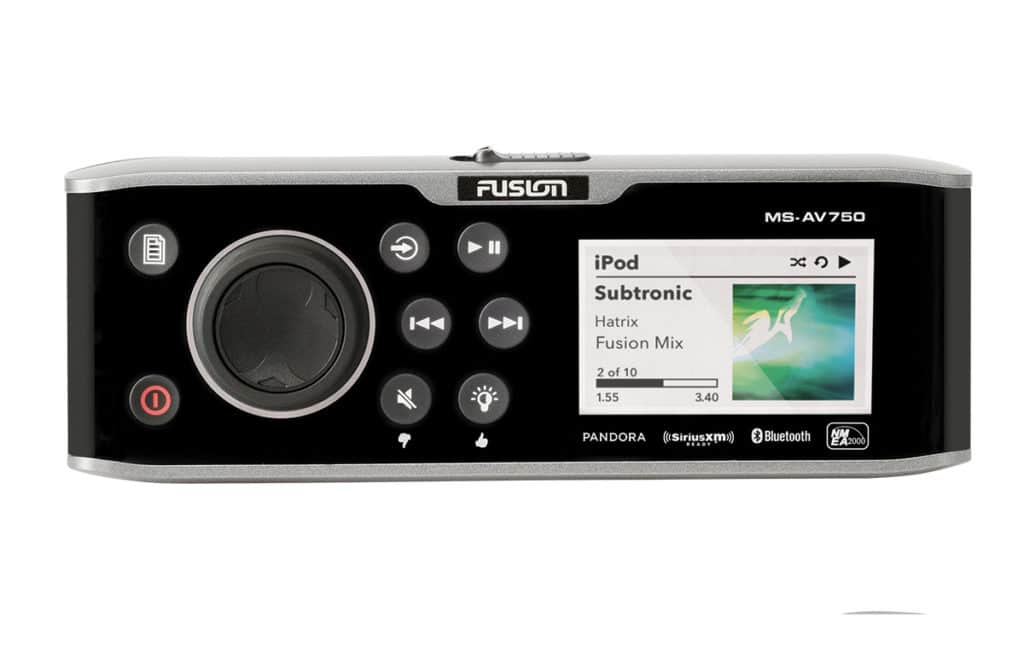
Fusion MS-AV750
Fusion MS-AV750
Cost: $750
The MS-AV750 gives the user plenty of breathing room to access controls, without taking up too much space at the helm. Some skippers fix the NRX 300 remote at the helm and position the MS-AV750 elsewhere — say a spot where there is no navigation display available. For a while, zone control, allowing different areas to have unique sound settings, was Fusion’s domain. NMEA offered new NMEA 2000 firmware to allow others to emulate it.
Wired Remote Model: The NRX 300 remote is waterproof and can be flush-mounted or dash-mounted conventionally. It gives full audio control to the source unit and can be configured to repeat navigation or instrumentation data via the NMEA 2000 backbone. Boatbuilders often put the remote on the helm and the source-unit control in a compartment.
Wireless Remote Model: Fusion-Link Wireless Remote is an app available in iOS or Android configurations and gives full control to the MS-AV750 and other Fusion models on any tablet or smartphone.
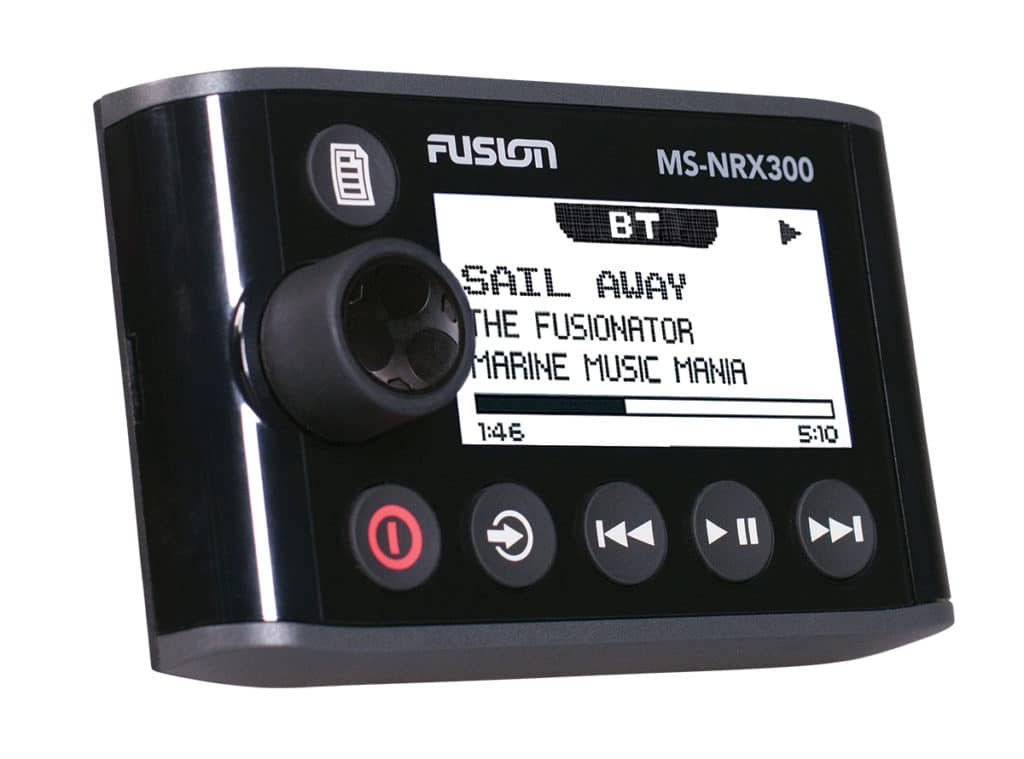
Integration Mode: Fusion-Link is integrated into its stereo packages and requires only a connection to the NMEA 2000 backbone that most navigation systems already support. It gives access to audio source, playlists, zone control, and volume and tone controls, allowing the skipper to fine-tune volume in various areas of the boat.
Additional Equipment: No gateway or black box is necessary, only a network cable to the NMEA 2000 backbone.
Interfaces With: Furuno, Garmin, Humminbird, Lowrance, Raymarine and Simrad
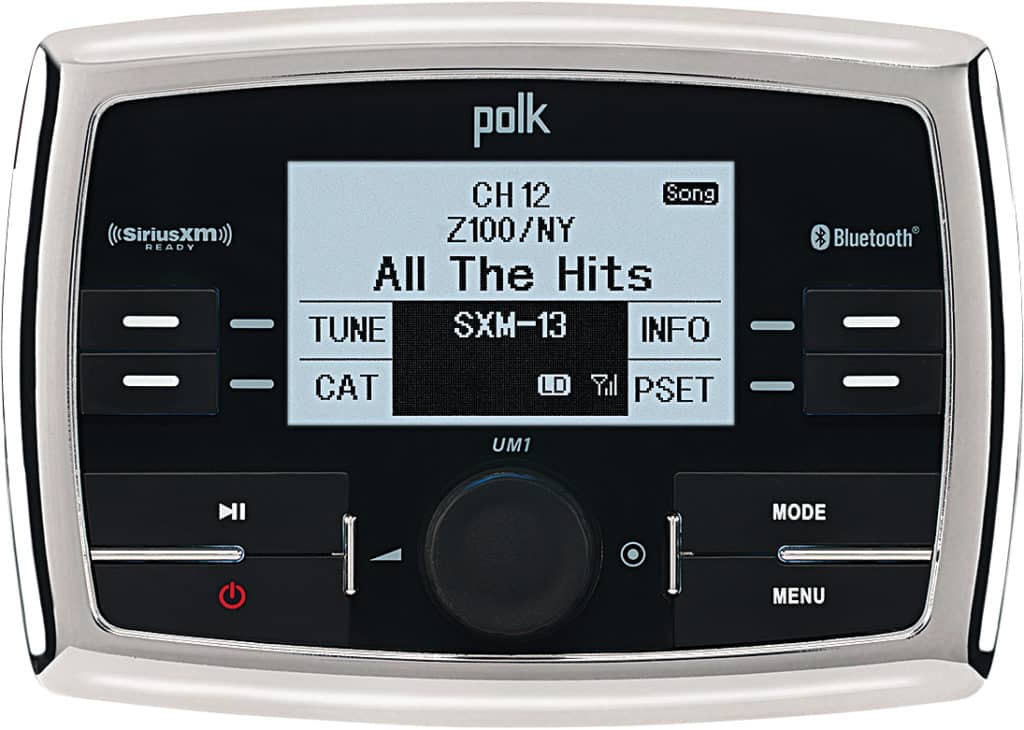
Polk Marine PA4A
Polk Marine PA4A
Cost: $530
The genius of the PA4A source unit is that its controller is essentially a wired remote that can be mounted on the dash with a bezel and a small hole, or it can be flush-mounted with a hole to fit the controller’s backing. The source unit is hard-wired but can be located dozens of feet away from the controller with an extension cable, giving maximum installation flexibility. Cool features include seven NOAA weather channels and PTY search, which allows the user to select and preset 18 FM, 12 AM and 18 satellite radio channels based on content selections like rock, country, sports, talk, etc.
Wired Remote Model: PRC200BC is waterproof for mounting flexibility and offers the full array of audio adjustments via a touch pad and backlit LCD screen. Like the source-unit control, it can be flush-mounted or surface-mounted with a bezel.
Wireless Remote Model: Via Bluetooth device
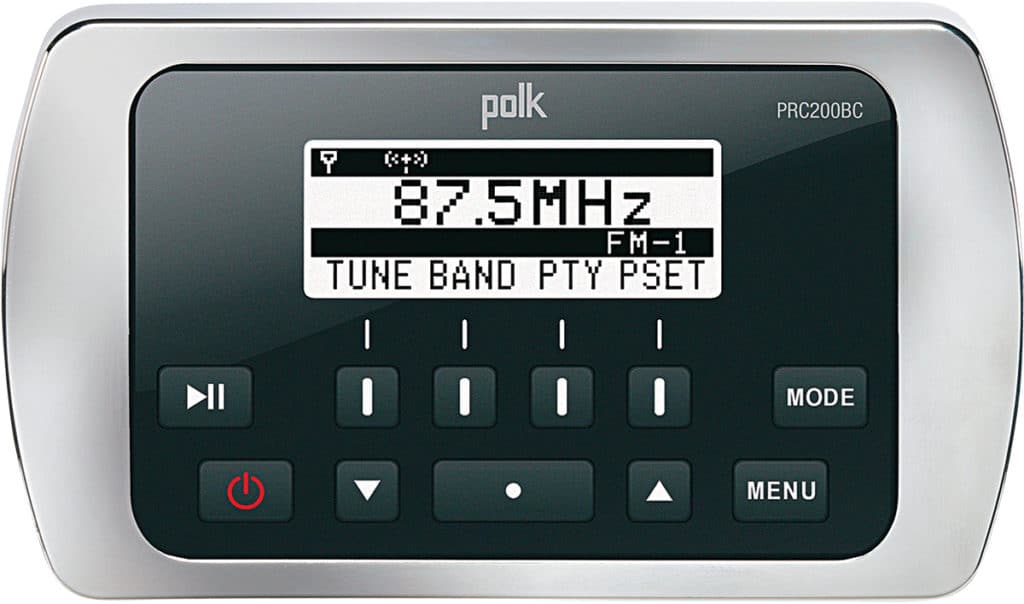
App: Ultramarine app operated with Bluetooth protocol allows anyone with a smart device to connect and control the audio, source unit and playlists, and to stream Pandora through the system.
Integration Mode: NMEA 2000 PGN requiring a Polk Audio gateway device
Additional Equipment: NMEA 2K1 gateway kit
Interfaces With: Garmin, Simrad and Lowrance devices via the NMEA 2000 network and a gateway device
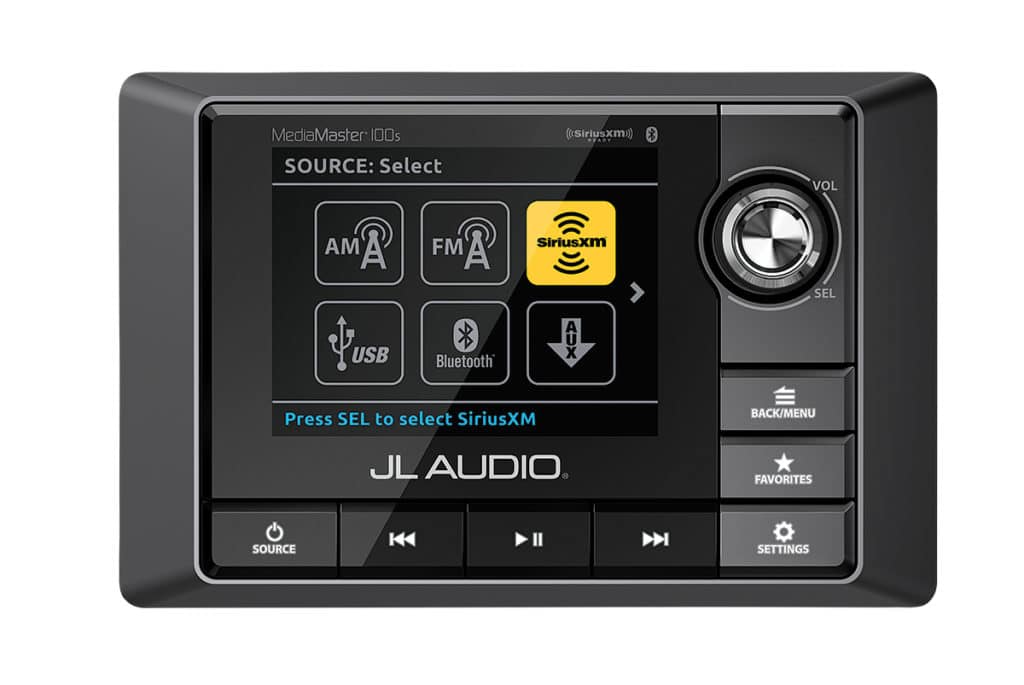
JL Audio Media Master MM100s
JL Audio Media Master MM100s
Cost: $500
The MM100s was introduced with integrated NMEA 2000 interconnectivity built into it and requires only a data link to the backbone and no black box. Media Master’s zone control allows Zone 1 to adjust the remaining zones. Those zones can be set at a percentage of Zone 1. So, if the skipper wanted full volume in the cockpit to overcome noise, the cabin might only need 50 percent volume and a reference can be set to automatically modulate the max volume of those zones. However, whether you integrate or not, just the combination of this color-control panel and MFD functionality makes JL a full-audio and one-stop system for industry-favorite speakers, amps and now source units. JL’s reputation for speaker quality draws stereo installers to the brand regardless of whose source unit and amplifier the user selects.
Wired Remote Model: MMR-20 ($110); Up to three of these 2-inch, backlit, weatherproof, IP67-rated units can be connected to the source unit for on/off, volume, source, fast forward/rewind, favorite channel up or down, play, pause and mute functions.
Wireless Remote Model: NA
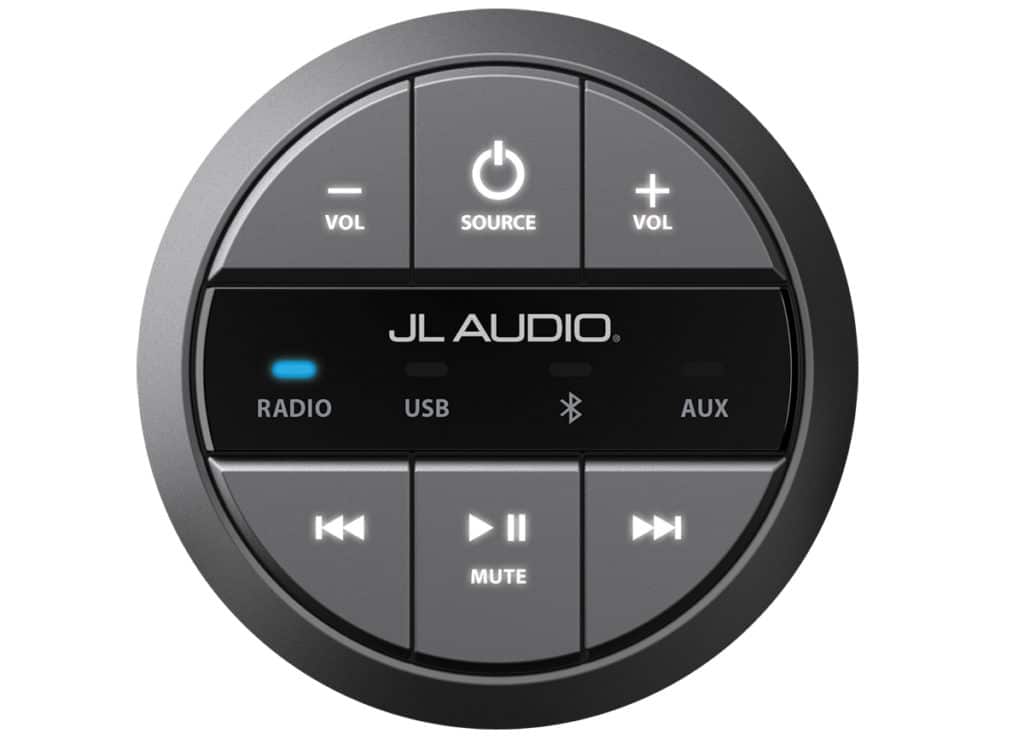
App: No app is available, however, the MM100s pairs with your device, and it regards it as an audio player and routes the device through the audio system.
Integration Mode: NMEA 2000 PGN protocol
Additional Equipment: NMEA 2000 connectivity is integrated, connection to the backbone is via MMC-DN2K data-link cable ($30 to $40)
Interfaces With: Garmin, Simrad and Lowrance
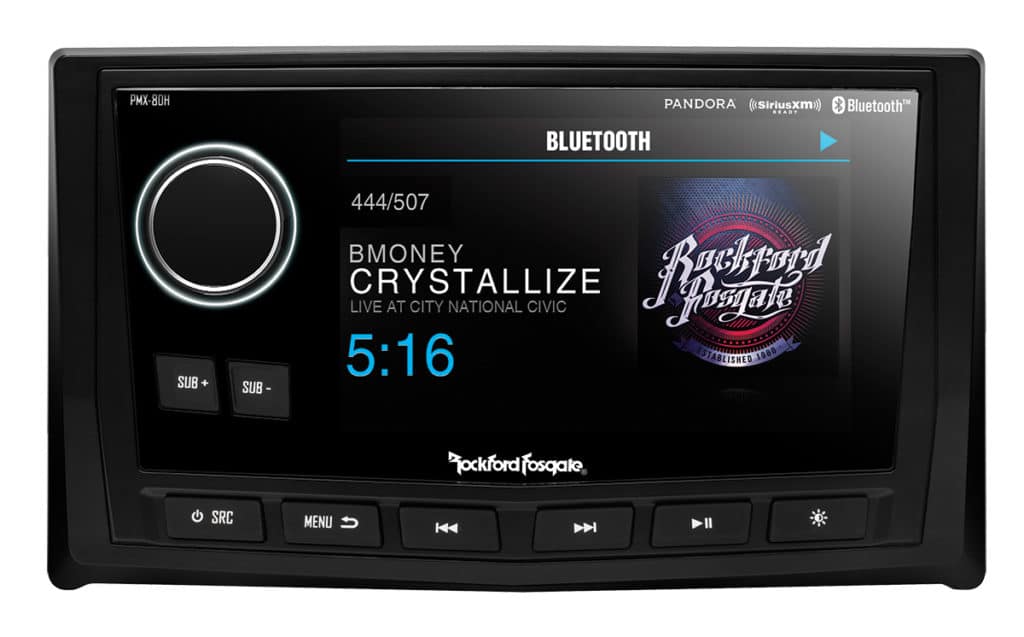
Rockford Fosgate PMX-8DH Display and PMX 8BB Receiver
Rockford Fosgate PMX-8DH Display and PMX 8BB Receiver
Cost: $350 Display; $400 Receiver
Rockford was the first to make a run at Fusion’s corner on the audio integration playing field and uses the NMEA 2000 network and its gateway black box to do so. It offers four-zone audio control. The two-part system allows audiophiles to stream audio from iOS or Android devices and SiriusXM receivers. The fully featured display is water-, fog- and dirt-resistant, as is the black-box receiver. The two-part system allows multiple displays to be mounted around the vessel or to use abbreviated remotes.
Wired Remote Model: Connect up to three PMX-8DH, PMX-1R ($200 with a 2.7-inch color screen) or PMX-0R ($100 without screen) remotes for fully functional source-unit control with location flexibility.
Wireless Remote Model: NA
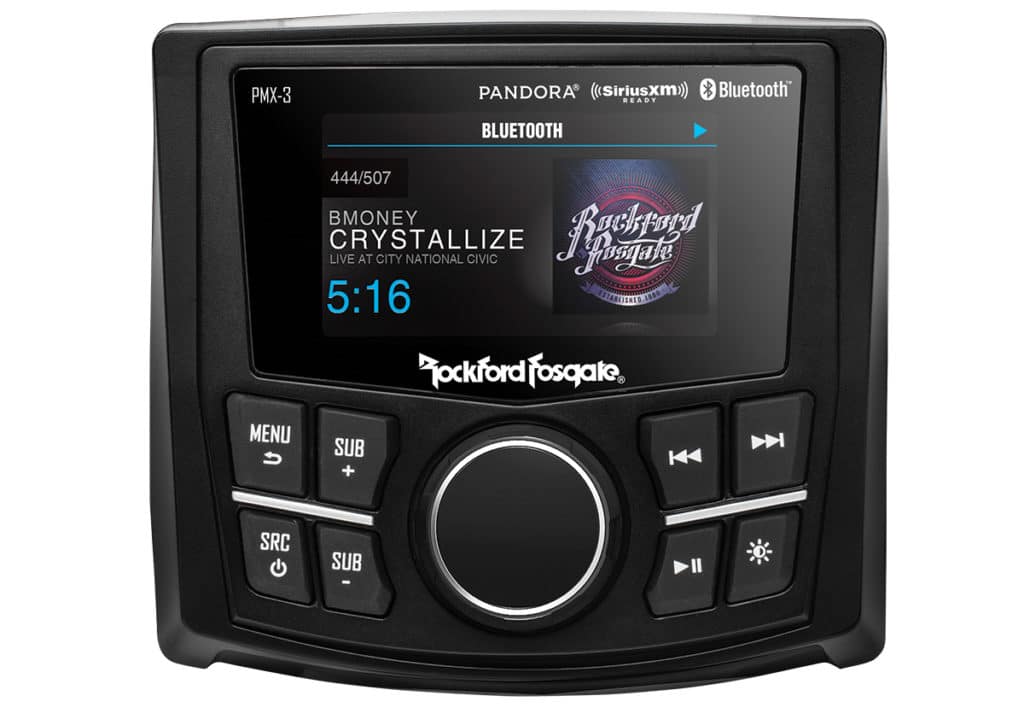
App: Bluetooth connectivity sources music from a paired iOS or Android device, giving folder and file display and play control.
Integration Mode: NMEA 2000 PGN protocol
Additional Equipment: PMX-CAN data link
Interfaces With: Raymarine, currently








